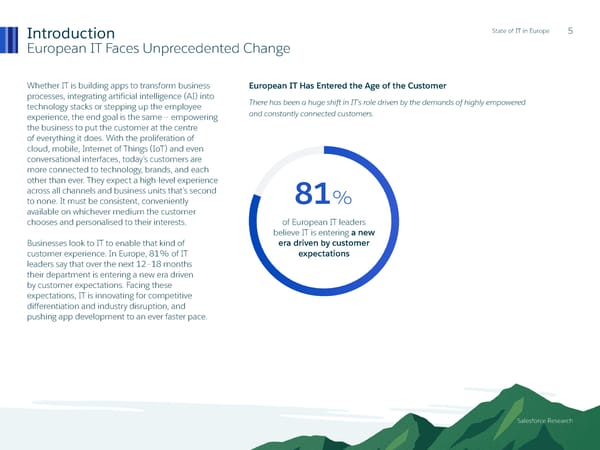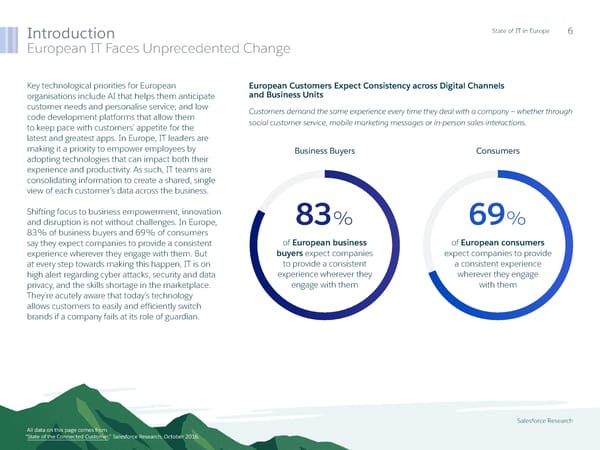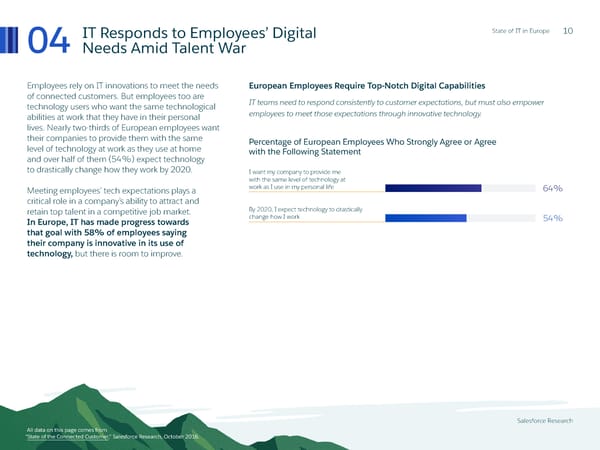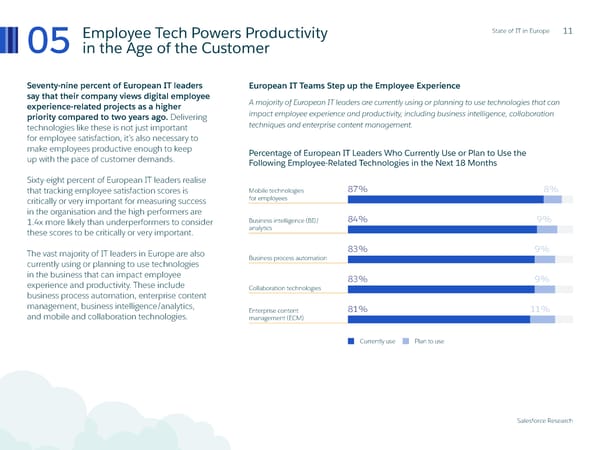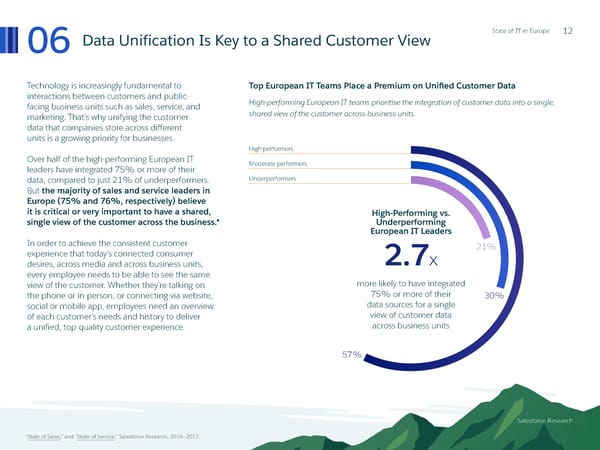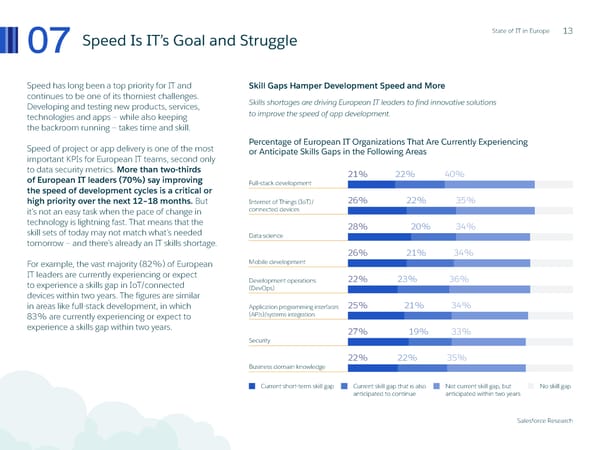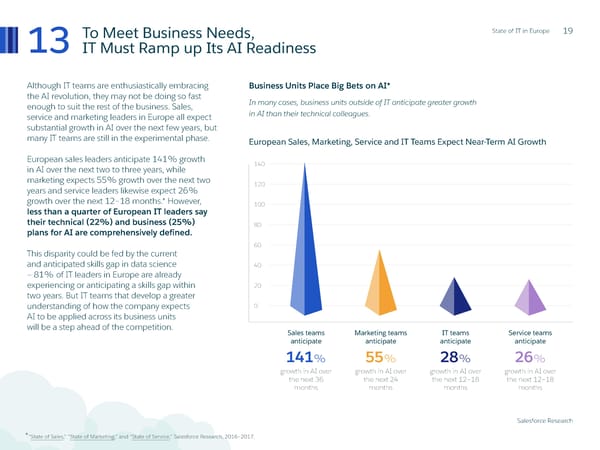State of IT in Europe
Regional Report | Transformative insights and growing trends from over 1,000 IT leaders
REGIONAL REPORT State of IT in Europe Transformative insights and growing trends from over 1,000 IT Leaders
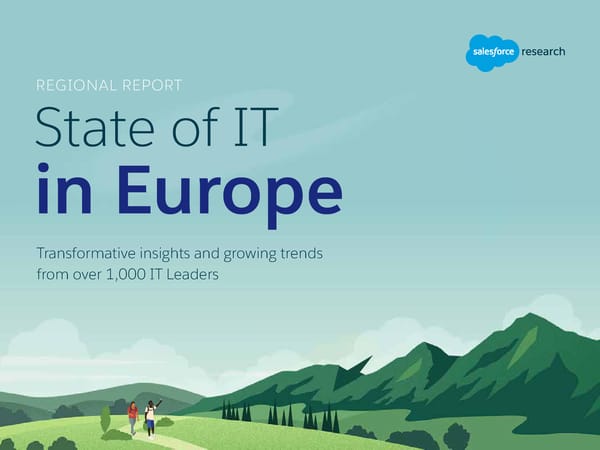
State of IT in Europe About This Report 2 Salesforce Research surveyed 1,005 IT leaders in France, Germany, the Netherlands, the United Kingdom and Ireland to discover: • The changing role of IT in a customer-driven era • Which strategies and technologies IT leaders in Europe are turning to for faster innovation • The continued impact of cybersecurity and data privacy 251 • The increasing importance of the 250 digital employee experience • The role of artificial intelligence (AI) in an evolving technology landscape 254 Data in this report is a subset of the second annual 250 “State of IT” study, a blind survey fielded January– February 2017, that generated responses from 2,263 full-time IT leaders (not limited to Salesforce customers) in the U.S., Canada, U.K./Ireland, France, Germany, Netherlands, Japan and Australia/New Zealand. All respondents are third-party panelists. Due to rounding, not all percentage totals in this report equal 100%. All comparison calculations are made from total numbers (not rounded numbers). Salesforce Research provides data-driven insights to help businesses transform how they drive customer success. Browse all reports at salesforce.com/research Salesforce Research
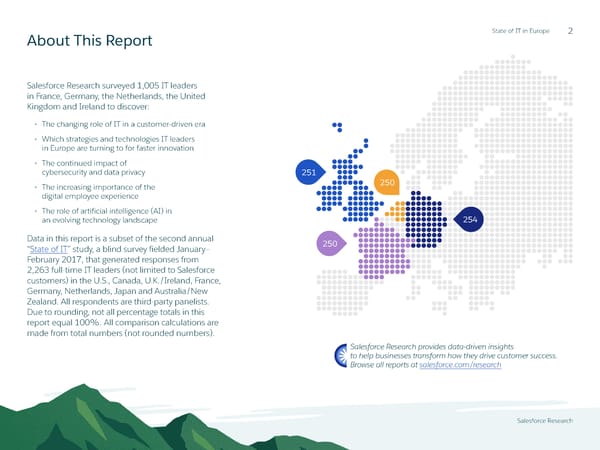
State of IT in Europe About This Report 3 A Closer Look at IT Performance Categories High-performing European IT teams represent 14% of the overall European survey population. Moderate performers either rate their performance versus the competition as above average or rate their performance versus the competition as excellent but not their overall IT performance Underperformers rate their performance versus the competition as average, below 61% average or poor High performers rate their performance versus the competition and overall IT performance as excellent 25% 14% Salesforce Research
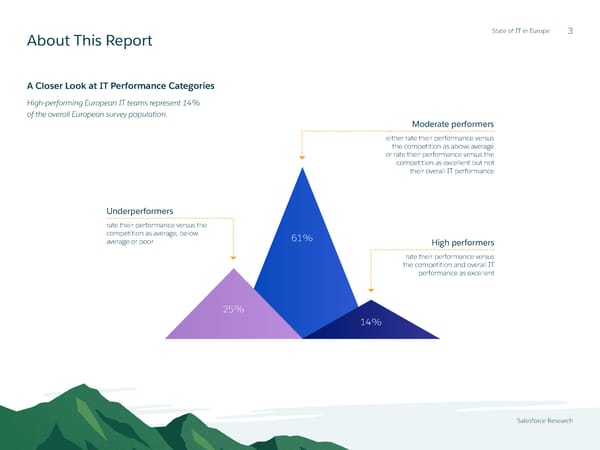
State of IT in Europe Table of Contents 4 Introduction: European IT Faces Unprecedented Change .................................................................. 5 In a Tech-Driven World, Customer Experience Is IT’s Top Job ................................................. 7 01 IT’s Focus Pivots from Infrastructure to Business Value ............................................................. 8 02 Technology Innovation Powers Business Differentiation and Disruption ............................... 9 03 IT Responds to Employees’ Digital Needs Amid Talent War ..................................................... 10 04 Employee Tech Powers Productivity in the Age of the Customer ............................................ 11 05 Data Unification Is Key to a Shared Customer View ................................................................... 12 06 Speed Is IT’s Goal and Struggle ..................................................................................................... 13 07 Low-Code and Citizen Development Ease IT’s Burden .............................................................. 14 08 IT Confronts Dual Challenges of Innovation and Protection .................................................... 15 09 Threats Evolve as Skills Dwindle ..................................................................................................... 16 10 European IT Steps into an Intelligent Future ............................................................................... 17 11 IT Teams Embrace the AI Revolution in Europe ......................................................................... 18 12 To Meet Business Needs, IT Must Ramp up Its AI Readiness ................................................... 19 13 Last Look: Europe’s Top Leaders Embrace Their New Mission ............................................................ 20 Salesforce Research
State of IT in Europe Introduction 5 European IT Faces Unprecedented Change Whether IT is building apps to transform business European IT Has Entered the Age of the Customer processes, integrating artificial intelligence (AI) into There has been a huge shift in IT’s role driven by the demands of highly empowered technology stacks or stepping up the employee and constantly connected customers. experience, the end goal is the same — empowering the business to put the customer at the centre of everything it does. With the proliferation of cloud, mobile, Internet of Things (IoT) and even conversational interfaces, today’s customers are more connected to technology, brands, and each other than ever. They expect a high-level experience across all channels and business units that’s second 81% to none. It must be consistent, conveniently available on whichever medium the customer chooses and personalised to their interests. of European IT leaders believe IT is entering a new Businesses look to IT to enable that kind of era driven by customer customer experience. In Europe, 81% of IT expectations leaders say that over the next 12–18 months their department is entering a new era driven by customer expectations. Facing these expectations, IT is innovating for competitive differentiation and industry disruption, and pushing app development to an ever faster pace. Salesforce Research
State of IT in Europe Introduction 6 European IT Faces Unprecedented Change Key technological priorities for European European Customers Expect Consistency across Digital Channels organisations include AI that helps them anticipate and Business Units customer needs and personalise service; and low- Customers demand the same experience every time they deal with a company — whether through code development platforms that allow them social customer service, mobile marketing messages or in-person sales interactions. to keep pace with customers’ appetite for the latest and greatest apps. In Europe, IT leaders are making it a priority to empower employees by Business Buyers Consumers adopting technologies that can impact both their experience and productivity. As such, IT teams are consolidating information to create a shared, single view of each customer’s data across the business. Shifting focus to business empowerment, innovation 83% 69% and disruption is not without challenges. In Europe, 83% of business buyers and 69% of consumers say they expect companies to provide a consistent of European business of European consumers experience wherever they engage with them. But buyers expect companies expect companies to provide at every step towards making this happen, IT is on to provide a consistent a consistent experience high alert regarding cyber attacks, security and data experience wherever they wherever they engage privacy, and the skills shortage in the marketplace. engage with them with them They’re acutely aware that today’s technology allows customers to easily and efficiently switch brands if a company fails at its role of guardian. Salesforce Research All data on this page comes from “State of the Connected Customer,” Salesforce Research, October 2016.
State of IT in Europe 01 In a Tech-Driven World, Customer 7 Experience Is IT’s Top Job Customers today are empowered like never before. Technology Empowers Customers to Switch Brands Effortlessly These individuals are connected, day and night, to European customers who don’t get the consistent experience they want from a company the companies they buy from, whether through the can go elsewhere with the swipe of a finger. web, mobile, IoT or social, and they expect every interaction to come with consistent, contextualised customer care. Percentage of European Customers Who Believe Technology Has Made It Business buyers, in particular, demand consistency Easier Than Ever before to Take Their Business Elsewhere across communication channels and throughout every business unit. Nearly 75% of European business buyers are likely to switch brands if Business buyers 78% they receive inconsistent levels of service — for example, when they’re dealing with a sales rep Consumers 68% versus a service rep. Technological innovations have created companies that are disrupting every industry — as Uber has done in transport and Airbnb has done in hospitality — offering products and services that were unimaginable just a few years ago. That’s why 78% of European business buyers and 68% of European consumers say that technology has made it easier than ever to take their business elsewhere. Salesforce Research All data on this page comes from “State of the Connected Customer,” Salesforce Research, October 2016.
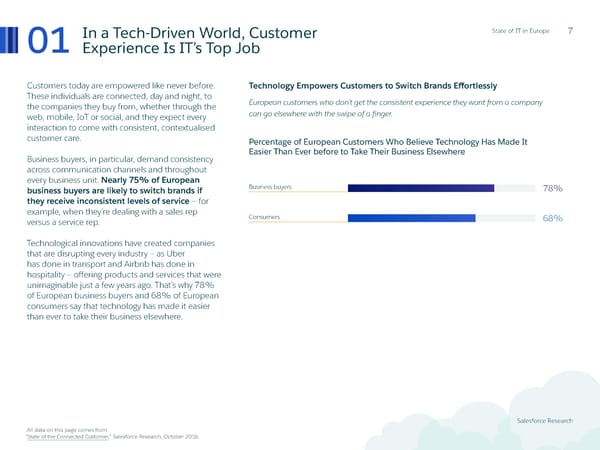
State of IT in Europe 02 IT’s Focus Pivots from Infrastructure to Business Value 8 Once upon a time, IT’s job was to “keep the lights European IT’s Mandate Expands in a New Era on.” Now, there is incredible pressure on IT to be IT teams in Europe are still “keeping the lights on,” but are more than ever the linchpin for the linchpin that gives businesses the capabilities business value in a hypercompetitive marketplace. and the innovations needed to carve out a place in a hypercompetitive marketplace. Over the next 12–18 months, 81% of European IT Percentage of European IT Leaders Who Believe leaders say that IT is entering a new era driven by the Following about IT’s Changing Role customer expectations and 76% believe that IT is in the midst of the biggest historical shift in its role IT is entering a new era driven yet. IT is not only expected to deliver innovation, by customer expectations 81% but it is also expected to be the primary enabler of customer experience initiatives, according to 79% IT is the primary enabler of customer of European IT leaders. experience initiatives 79% Companies need to see IT in a new light if they want IT is currently in the midst of the biggest to harness technology to help them craft quality historical shift in its role 76% customer experiences that will differentiate them in the marketplace. And IT teams need to respond with an expanded view of their role. High-performing European IT leaders are 1.3x more likely than underperformers to believe that IT works as an extension or partner to business units, rather than as a separate function. Salesforce Research
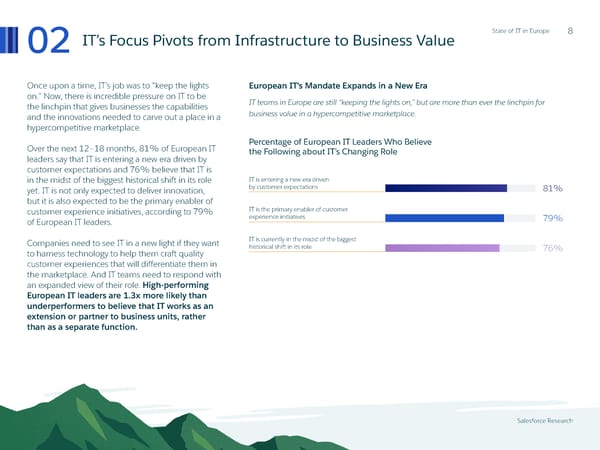
State of IT in Europe 03 Technology Innovation Powers Business 9 Differentiation and Disruption IT plays a key role in meeting new expectations for European IT Leaders Say IT Is a Guiding Light into New Markets customer care, but it also needs to innovate around IT teams can propel their firms into new territories and markets, disrupt industries new products, services and delivery. and enable businesses to grow. High-Performing vs. Underperforming European IT Leaders 4.0x more likely to say innovation for industry disruption is a critical priority over the next 12–18 months 79% of European IT leaders believe IT teams can help companies to disrupt the that IT is the primary enabler marketplace, but they can also go further. Nearly of businesses entering new four-fifths of European IT leaders believe IT is the markets/exploring new primary enabler of businesses entering new markets opportunities in the next or exploring new opportunities. 12–18 months IT is no longer an isolated function operating separately from the business — it needs to be the disruptor and the innovator, while reaching every customer and providing them with a consistent, high level of service. Two-thirds (66%) of European IT leaders say innovation for competitive differentiation is a critical or high priority for their organisation over the next 12–18 months. Salesforce Research
State of IT in Europe 04 IT Responds to Employees’ Digital 10 Needs Amid Talent War Employees rely on IT innovations to meet the needs European Employees Require Top-Notch Digital Capabilities of connected customers. But employees too are IT teams need to respond consistently to customer expectations, but must also empower technology users who want the same technological employees to meet those expectations through innovative technology. abilities at work that they have in their personal lives. Nearly two-thirds of European employees want their companies to provide them with the same Percentage of European Employees Who Strongly Agree or Agree level of technology at work as they use at home with the Following Statement and over half of them (54%) expect technology to drastically change how they work by 2020. I want my company to provide me with the same level of technology at Meeting employees’ tech expectations plays a work as I use in my personal life 64% critical role in a company’s ability to attract and retain top talent in a competitive job market. By 2020, I expect technology to drastically In Europe, IT has made progress towards change how I work 54% that goal with 58% of employees saying their company is innovative in its use of technology, but there is room to improve. Salesforce Research All data on this page comes from “State of the Connected Customer,” Salesforce Research, October 2016.
State of IT in Europe 05 Employee Tech Powers Productivity 11 in the Age of the Customer Seventy-nine percent of European IT leaders European IT Teams Step up the Employee Experience say that their company views digital employee A majority of European IT leaders are currently using or planning to use technologies that can experience-related projects as a higher impact employee experience and productivity, including business intelligence, collaboration priority compared to two years ago. Delivering technologies like these is not just important techniques and enterprise content management. for employee satisfaction, it’s also necessary to make employees productive enough to keep Percentage of European IT Leaders Who Currently Use or Plan to Use the up with the pace of customer demands. Following Employee-Related Technologies in the Next 18 Months Sixty-eight percent of European IT leaders realise that tracking employee satisfaction scores is Mobile technologies 87% 8% critically or very important for measuring success for employees in the organisation and the high-performers are 84% 9% 1.4x more likely than underperformers to consider Business intelligence (BI)/ these scores to be critically or very important. analytics The vast majority of IT leaders in Europe are also 83% 9% currently using or planning to use technologies Business process automation in the business that can impact employee 83% 9% experience and productivity. These include Collaboration technologies business process automation, enterprise content management, business intelligence/analytics, Enterprise content 81% 11% and mobile and collaboration technologies. management (ECM) Currently use Plan to use Salesforce Research
State of IT in Europe 06 Data Unification Is Key to a Shared Customer View 12 Technology is increasingly fundamental to Top European IT Teams Place a Premium on Unified Customer Data interactions between customers and public- High-performing European IT teams prioritise the integration of customer data into a single, facing business units such as sales, service, and shared view of the customer across business units. marketing. That’s why unifying the customer data that companies store across different units is a growing priority for businesses. High performers Over half of the high-performing European IT Moderate performers leaders have integrated 75% or more of their data, compared to just 21% of underperformers. Underperformers But the majority of sales and service leaders in Europe (75% and 76%, respectively) believe it is critical or very important to have a shared, High-Performing vs. single view of the customer across the business.* Underperforming European IT Leaders In order to achieve the consistent customer 21% experience that today’s connected consumer 2.7x desires, across media and across business units, every employee needs to be able to see the same view of the customer. Whether they’re talking on more likely to have integrated the phone or in-person, or connecting via website, 75% or more of their 30% social or mobile app, employees need an overview data sources for a single of each customer’s needs and history to deliver view of customer data a unified, top-quality customer experience. across business units 57% Salesforce Research “State of Sales,” and “State of Service,” Salesforce Research, 2016–2017.
State of IT in Europe 07 Speed Is IT’s Goal and Struggle 13 Speed has long been a top priority for IT and Skill Gaps Hamper Development Speed and More continues to be one of its thorniest challenges. Skills shortages are driving European IT leaders to find innovative solutions Developing and testing new products, services, to improve the speed of app development. technologies and apps — while also keeping the backroom running — takes time and skill. Speed of project or app delivery is one of the most Percentage of European IT Organizations That Are Currently Experiencing important KPIs for European IT teams, second only or Anticipate Skills Gaps in the Following Areas to data security metrics. More than two-thirds 21% 22% 40% of European IT leaders (70%) say improving Full-stack development the speed of development cycles is a critical or high priority over the next 12–18 months. But Internet of Things (IoT)/ 26% 22% 35% it’s not an easy task when the pace of change in connected devices technology is lightning fast. That means that the 28% 20% 34% skill sets of today may not match what’s needed Data science tomorrow — and there’s already an IT skills shortage. 26% 21% 34% For example, the vast majority (82%) of European Mobile development IT leaders are currently experiencing or expect Development operations 22% 23% 36% to experience a skills gap in IoT/connected (DevOps) devices within two years. The figures are similar in areas like full-stack development, in which Application programming interfaces 25% 21% 34% 83% are currently experiencing or expect to (APIs)/systems integration experience a skills gap within two years. 27% 19% 33% Security 22% 22% 35% Business domain knowledge Current short-term skill gap Current skill gap that is also Not current skill gap, but No skill gap anticipated to continue anticipated within two years Salesforce Research
State of IT in Europe 08 Low-Code and Citizen Development Ease IT’s Burden 14 There are some emerging answers to the need for Top European IT Leaders Embrace Citizen Development speed. In particular, low-code development (also The lightning fast pace of change in technology, Europe’s IT skills shortage, and new low-code referred to as component-based architecture) development platforms are prompting IT teams to shift application building to end users. is increasingly viewed by top teams as a viable tactic for increasing efficiency. High-performing IT leaders in Europe are 2x more likely than underperformers to consider low-code High performers development a critical or high priority. Moderate performers Low-code development also opens the door Underperformers to another time-saving measure: a trend 86% commonly referred to as “citizen development.” High-Performing vs. Seventy-four percent of European IT leaders Underperforming say they’ll increasingly shift some app-building European IT Leaders responsibility to business users over the next 12–18 months. High performers are 1.3x 1.3x more likely than underperformers to say so. 74% more likely to say IT will increasingly shift 65% some application- building responsibilities to business users Salesforce Research
State of IT in Europe 09 IT Confronts Dual Challenges of 15 Innovation and Protection Customers now demand a myriad of digital European IT Leaders Say Cloud Security Has Improved touchpoints from businesses, enabling the Despite shifting customer and business data regulations, most IT leaders in Europe anywhere, anytime experiences they require, but say cloud security has improved. also introducing new vulnerabilities that make security more important than ever. The business value of security is underscored by the fact that many customers will avoid businesses that are breached or leave personal data exposed. Seventy- two percent of European consumers and 75% of European business buyers are likely to switch brands in the wake of a data breach.* 80% Businesses in Europe are also concerned that moving their data into the cloud or integrating data of European IT leaders sources across business units will inhibit them from believe cloud security meeting data protection requirements. For instance, has improved over the such firms worry that handing over their data to past five years cloud providers requires moving it to a data center outside of Europe, though this is often not the case. Although 80% of European IT leaders believe cloud security has improved over the past five years, there is still wariness around data privacy in the cloud, particularly as regulations around customer and business data protection are nebulous. Staying abreast of the latest rules — and how products, services and data storage adhere to them — is key to IT success. Salesforce Research *“State of the Connected Customer,” Salesforce Research, October 2016.
State of IT in Europe 10 Threats Evolve as Skills Dwindle 16 Regardless of how IT’s role changes, security Data Security Tops the Agenda for European IT Leaders remains a top concern. The majority of IT teams in Europe cite cybersecurity as their top concern in an evolving threat landscape. European IT leaders (71%) say that improving security policies and practices is a critical or high priority for their organisation over Percentage of European IT Leaders Who Rate the Following as Critically or the next 12–18 months. And data security Very Important KPIs for Measuring Success metrics are the number one KPI — cited by 76% of European IT leaders as critically or very important for measuring IT’s success. Data security metrics 76% But achieving a top level of security and data privacy is an ongoing process. The threat landscape Speed of application/project delivery 74% is constantly evolving from types of malware to methods of intrusion — and the number and scope Satisfaction metrics (e.g., net promoter score of devices and apps to be secured is always growing. (NPS), Customer satisfaction (CSAT)) 72% In addition, the cybersecurity skills shortage is a large concern. Security skills are the second largest gap in Europe behind data science, and 79% of European IT leaders say they’re currently experiencing or expect a lack of security skills within the next two years. Salesforce Research
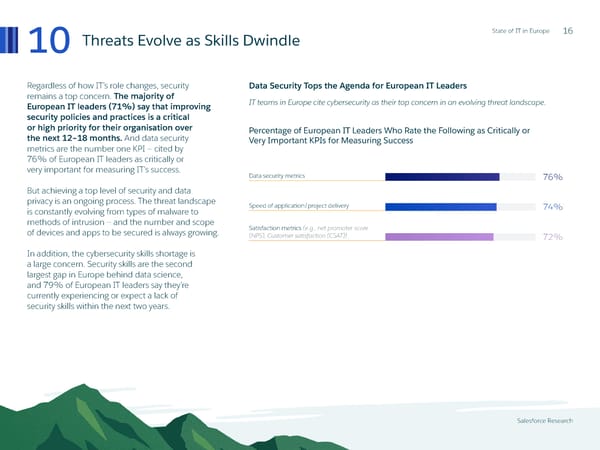
State of IT in Europe 11 European IT Steps into an Intelligent Future 17 AI is finally making a significant mark across European Employees Expect Big Things from AI in the near Future industries and the marketplace only expects its AI is making a significant mark across industries and employees expect influence to grow. Both consumers and business the technology to revolutionise the way they work. users know that companies are using AI to better analyse and meet their needs and expectations — and that has, in turn, created an expectation that Percentage of European Employees Who Expect the businesses will better understand them in the future. Following Technologies to Have a Major or Moderate Impact on Their Daily Work Life by 2020 In Europe, over two-thirds (69%) of consumers and 85% of business buyers say they expect Predictive intelligence that allows sales, companies to understand their needs and service and marketing teams to anticipate expectations. By 2020, over half of European customer needs and prioritise tasks 59% employees expect that AI, predictive intelligence and deep learning will have a moderate to major Deep learning to classify, predict and react impact on their daily working lives. They expect to patterns within data 58% product recommendations that are more accurate Artificial intelligence to automate or assist and personal, chatbots that can accurately and in work-related activities 55% efficiently answer their questions, and sales, service and marketing teams that can anticipate their needs. Salesforce Research All data on this page comes from “State of the Connected Customer,” Salesforce Research, October 2016.

State of IT in Europe 12 IT Teams Embrace the AI Revolution in Europe 18 For IT, AI has moved beyond the hype and is being European Companies Embrace AI adopted and integrated into every part of the AI is being rolled out across European organisations in test pilots business — from business operations to marketing and even across business units. to customer service and sales. With AI, businesses can understand and predict customer behaviour, analyse big data more deeply to draw greater Extent to Which Companies in Europe Using or Planning to insights, and even help customer engagement in Use AI Will Implement It over the Next 18 Months the form of natural-language service chatbots. Just under two-thirds of European IT leaders (63%) 36% are using AI in some capacity within their business, Our company’s artificial 39% with 36% of those saying they’ve implemented AI intelligence business plans 20% on a companywide basis. European IT leaders also expect AI to grow over the next 12–18 months, Companywide implementation anticipating a 28% surge in the technology. Departmental implementation The widespread adoption of AI is arguably a Project-based implementation/experimentation byproduct of the shift in IT’s focus towards meeting customer expectations. AI and deep machine learning can help companies extract highly nuanced insights into customer behaviour and thereby offer personal, tailored marketing and customer service that addresses each individual’s needs. Salesforce Research
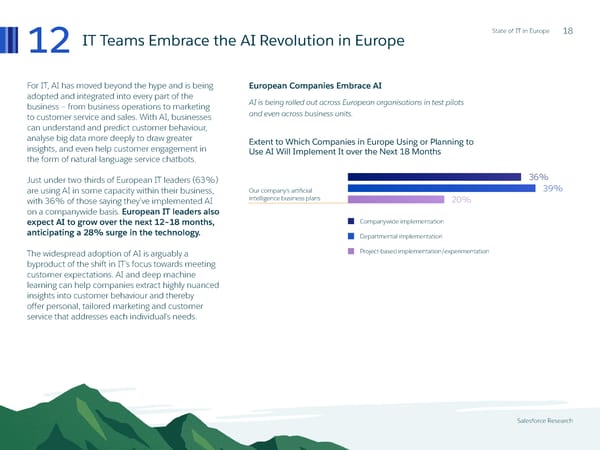
State of IT in Europe 13 To Meet Business Needs, 19 IT Must Ramp up Its AI Readiness Although IT teams are enthusiastically embracing Business Units Place Big Bets on AI* the AI revolution, they may not be doing so fast In many cases, business units outside of IT anticipate greater growth enough to suit the rest of the business. Sales, in AI than their technical colleagues. service and marketing leaders in Europe all expect substantial growth in AI over the next few years, but many IT teams are still in the experimental phase. European Sales, Marketing, Service and IT Teams Expect Near-Term AI Growth European sales leaders anticipate 141% growth 140 in AI over the next two to three years, while marketing expects 55% growth over the next two 120 years and service leaders likewise expect 26% growth over the next 12–18 months.* However, 100 less than a quarter of European IT leaders say their technical (22%) and business (25%) 80 plans for AI are comprehensively defined. 60 This disparity could be fed by the current and anticipated skills gap in data science 40 — 81% of IT leaders in Europe are already experiencing or anticipating a skills gap within 20 two years. But IT teams that develop a greater understanding of how the company expects 0 AI to be applied across its business units will be a step ahead of the competition. Sales teams Marketing teams IT teams Service teams anticipate anticipate anticipate anticipate 141% 55% 28% 26% growth in AI over growth in AI over growth in AI over growth in AI over the next 36 the next 24 the next 12–18 the next 12–18 months months months months Salesforce Research *“State of Sales,” “State of Marketing,” and “State of Service,” Salesforce Research, 2016–2017.
State of IT in Europe Last Look 20 Europe’s Top IT Leaders Embrace Their New Mission IT’s role is fundamentally changing. In everything that IT does, the customer is now at the centre. High-Performing vs. As a result, IT has also found itself in a leading role Underperforming in almost every aspect of the business. The highest- European IT Leaders performing European IT leaders recognise that technology supports every facet of the business, High-Performing vs. 4.0x from customer service to product innovation, and Underperforming from market expansion to industry disruption. European IT Leaders more likely to rate innovation for industry disruption 3.6x as a critical priority more likely to rate improving the employee experience as a critical priority High-Performing vs. Underperforming High-Performing vs. European IT Leaders Underperforming European IT Leaders 2.7x 3.3x more likely to rate improving IT’s collaboration more likely to rate providing with lines of business a shared, single view of the as a critical priority customer as a critical priority Salesforce Research
Browse all reports at salesforce.com/research

